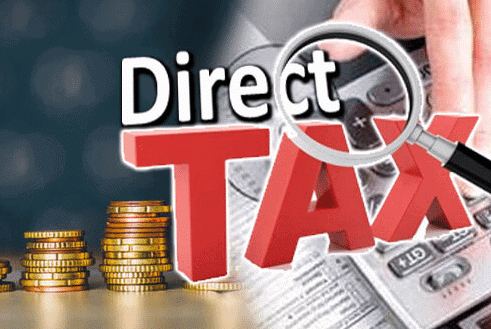NCERT Summary: Stock Markets in India- 3 | Indian Economy for UPSC CSE PDF Download
| Table of contents |

|
| TAX Collections |

|
| Direct Taxes |

|
| Indirect Taxes |

|
| Service Tax and its Transition |

|
| GST and Constitutional Framework |

|
| Future Outlook |

|
TAX Collections
The Government of India's tax receipts for the fiscal year 2023-24 reached approximately Rs. 32.61 lakh crores, reflecting significant growth due to robust economic performance and enhanced tax compliance measures. Direct taxes accounted for 58.4% of total tax revenue, underscoring the increasing reliance on income and corporate tax collections to fund social and developmental initiatives.Reasons for Increased Tax Collections:
- Strong Economic Growth: The Indian economy has grown at an average annual rate of 7% over the past decade.
- Rising Incomes: Higher disposable incomes have resulted in greater direct tax contributions.
- Improved Compliance: Simplified tax procedures, such as e-filing, have enhanced compliance rates.
- Technological Integration: Advanced analytics and AI-based systems are used for efficient tax administration and to identify tax evasion.
- Broadening the Tax Base: Continuous efforts to bring more individuals and businesses into the tax net.

Direct Taxes
Direct taxes remain a key contributor to government revenues.- Corporate Tax: Growth in corporate tax collections has been consistent due to the stabilization of the global economy post-pandemic and incentives for startups and MSMEs.
- Personal Income Tax: Revised tax slabs in recent budgets have increased collections while making compliance easier for taxpayers.
Recent reforms include:
Updated Tax Slabs (2025):
- 0% for income up to Rs. 3 lakh
- 5% for income between Rs. 3 lakh and Rs. 7.5 lakh
- 10% for income between Rs. 7.5 lakh and Rs. 15 lakh
- 20% for income above Rs. 15 lakh
- 30% surcharge on ultra-high incomes exceeding Rs. 2 crore
- E-Initiatives: Implementation of real-time monitoring and faceless assessment systems to reduce human intervention.
Indirect Taxes
Goods and Services Tax (GST):Introduced in 2017, GST has emerged as a game-changer in indirect taxation by replacing multiple taxes like VAT, excise duty, and service tax. The GST structure in 2025 includes:
- Rates: Four-tier rate structure — 5%, 12%, 18%, and 28%.
- Collections: GST revenues have grown steadily, crossing Rs. 1.6 lakh crore monthly on average in 2024-25.
GST Benefits:
- Simplifies tax compliance for businesses.
- Reduces cascading tax effects.
- Enhances ease of doing business.
Challenges:
- Bringing petroleum products, alcohol, and electricity under GST remains a point of contention.
- Rationalizing tax slabs to achieve a uniform rate is ongoing.
Service Tax and its Transition
Service tax, a precursor to GST, has been subsumed into the GST regime. However, certain legacy disputes related to service tax collection prior to 2017 are still being addressed through dedicated tribunals.Technology and Tax Administration
The Income Tax Department and GST Network (GSTN) rely on advanced technologies to enhance efficiency. Key initiatives include:
- E-Invoicing: Mandated for businesses with annual turnover exceeding Rs. 5 crore.
- Automated Refund Systems: Expedited refund processing for exporters and MSMEs.
- Artificial Intelligence: Identifying non-compliant taxpayers and fraud detection.
Goods and Services Tax Council and Reforms
The GST Council plays a pivotal role in ensuring harmonious tax implementation across the nation. Recent reforms include:
- Reduction of Tax Rates: Certain goods and services moved to lower tax brackets to stimulate demand.
- Expansion of Composition Scheme: Small businesses with turnover up to Rs. 2 crore now benefit from simplified GST compliance.
GST and Constitutional Framework
GST, governed under Article 246A, empowers both the Centre and states to levy and collect GST. Petroleum products and alcohol remain outside the GST ambit, while efforts to bring them under the regime continue.
Emerging Challenges and Solutions
- Integration of New Sectors: Efforts are underway to include emerging sectors like cryptocurrencies under the GST framework.
- Taxpayer Education: Increasing awareness about compliance requirements.
- State-Centre Coordination: Addressing revenue-sharing concerns effectively.
- Simplifying Tax Rates: Ongoing efforts to converge tax slabs for better efficiency.
Impact of GST on India’s Economy
- Enhanced Tax-to-GDP Ratio: Increased from 11.8% in 2011-12 to 13.7% in 2024-25.
- Boost to Exports: Exporters benefit from zero-rating under GST, making Indian goods globally competitive.
- Economic Growth: Lower compliance costs and simplified procedures have encouraged investments.
[Intext Question]
Future Outlook
India’s tax ecosystem is poised for greater advancements with the integration of technology, policy simplifications, and enhanced taxpayer services. The focus remains on creating a fair, transparent, and growth-oriented taxation system that meets the demands of a rapidly evolving economy.|
138 videos|431 docs|128 tests
|
FAQs on NCERT Summary: Stock Markets in India- 3 - Indian Economy for UPSC CSE
| 1. भारतीय शेयर बाजार क्या है और यह कैसे कार्य करता है? |  |
| 2. शेयर बाजार में निवेश करने के क्या लाभ हैं? |  |
| 3. भारतीय शेयर बाजार के प्रमुख सूचकांक कौन से हैं? |  |
| 4. शेयर बाजार में निवेश करने के लिए क्या रणनीतियाँ अपनाई जानी चाहिए? |  |
| 5. भारतीय शेयर बाजार में जोखिमों को कैसे प्रबंधित किया जा सकता है? |  |




















